May 2025
The global green hydrogen market size is calculated at USD 12.31 billion in 2025 and is forecasted to reach around USD 199.22 billion by 2034, accelerating at a CAGR of 41.46% from 2025 to 2034. The Asia Pacific market size surpassed USD 4.15 billion in 2024 and is expanding at a CAGR of 41.96% during the forecast period. The market sizing and forecasts are revenue-based (USD Million/Billion), with 2024 as the base year.
The global green hydrogen market size accounted for USD 8.78 billion in 2024 and is predicted to increase from USD 12.31 billion in 2025 to approximately USD 199.22 billion by 2034, expanding at a CAGR of 41.46% from 2025 to 2034.
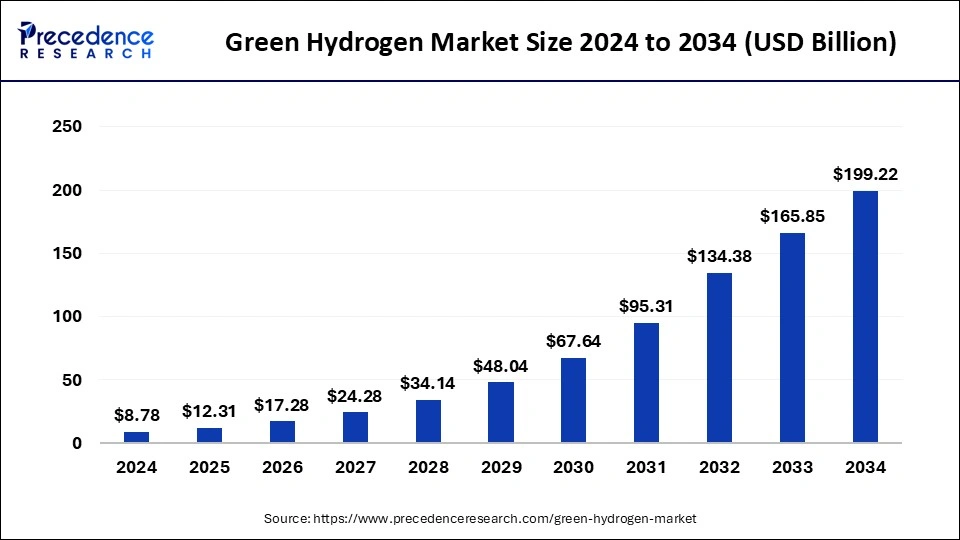
The Asia Pacific green hydrogen market size was evaluated at USD 4.15 billion in 2024 and is projected to be worth around USD 97.08 billion by 2034, growing at a CAGR of 41.96% from 2025 to 2034.
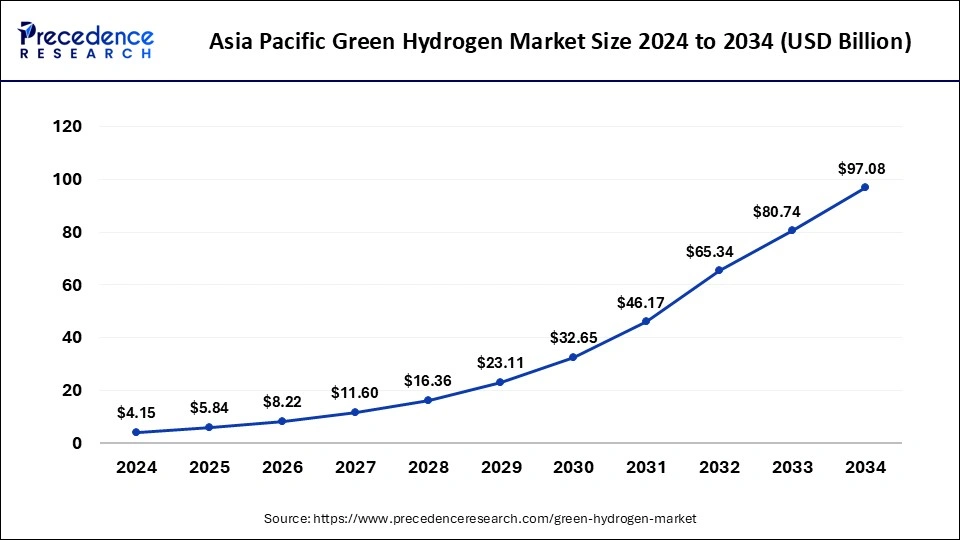
Based on the region, the Asia-Pacific segment dominated the global green hydrogen market in 2024, in terms of revenue and is estimated to sustain its dominance during the forecast period. China accounts for the largest market share in the Asia-Pacific green hydrogen market. With a 20-million-ton output, China leads the global green hydrogen market, accounting one third of global production.
Asia Pacific dominated the global green hydrogen market with the largest share in 2024. Favourable policies and initiatives by governments in the region are promoting the adoption of clean energy solutions like green hydrogen. Abundance of renewable energy resources such as solar, hydro ad wind is contributing to cost-effective production of green hydrogen through electrolysis. Additionally, growing focus on reducing carbon emissions, advancements in electrolyzer technology, rising investments in renewable energy infrastructure for energy security as well as increased collaborations between local and international companies for deploying large-scale green hydrogen projects is bolstering the region’s market growth. Regional players, like Australia, Japan and South Korea are highly focused on adoption of green hydrogen.
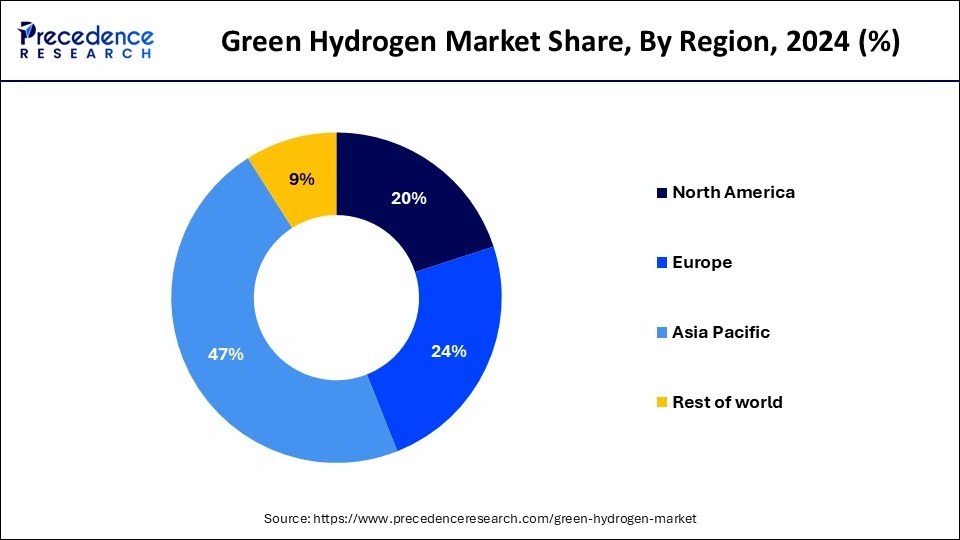
On the other hand, the Europe segment also held the notable share in market. The hydrogen is the primary source of energy in Europe. The European Green Deal aims to reduce greenhouse gas emissions while also preparing Europe’s economy for a climate-neutral future.
Green hydrogen is hydrogen produced entirely from renewable sources. Green hydrogen emits much less CO2 than grey hydrogen, which is made by steam reforming natural gas and accounts for 95% of the market.
The green electricity or power can be converted into a transportation fuel or used as a feedstock in industrial operations using green hydrogen as a link between them. Green hydrogen and derived fuels, such as green ammonia, will allow market players to integrate wind energy into a container ship’s fuel tank. As a result, hydrogen has the potential to considerably increase the decarbonization potential of renewable energy sources.
Hydrogen produced from renewable sources can be transformed into heat or electricity and used in a variety of ways for residential energy and electricity supply. As a result, in the case of weather-related power fluctuations, renewable energies will always be available in sufficient amount.
At the moment, fossil fuels account for 96% of hydrogen production. The traditional mode of production emits climate-disrupting carbon dioxide into the atmosphere. On the other hand, water is electrolyzed into hydrogen and oxygen in the power-to-gas technique.While the hydrogen is being used, the by-product oxygen can be reused or released into the environment.
Hydrogen is the most abundant element on the planet and offers tremendous promise for innovation. It can be used as a fuel or source of energy, as well as raw material in manufacturing industry. Electrolysis technologies are on the verge of becoming profitable, and fuel-cell systems are already in use. However, in fact for hydrogen from power-to-gas facilities to be successfully marketed economically, Germany has set to build a technology-open legal environment for the use of green hydrogen on a large scale.
Due to its ability to cut carbon emissions, green hydrogen has been in great demand in recent years. It also helps meet the world’s rising needs. Because it is a long-term energy source, its use is projected to rise. The global green hydrogen market is predicted to develop as people become more aware of the benefits of using hydrogen as an energy carrier. Furthermore, the industry is being driven by an increase in environmental concerns, emphasizing the need for clean energy generation to reduce emissions.
Moreover, the green hydrogen business is growing as the usage of nuclear and green hydrogen fuels increases. However, the initial investment required to set up hydrogen infrastructure, as well as prohibitive maintenance costs, are the principal issues limiting the growth of the green hydrogen market.
Due to the rise in rules and laws favoring green hydrogen in the energy sector, the green hydrogen market will see a boost in revenue. This is in addition to growing environmental worries over increased carbon emissions from the use of fossil fuels. Moreover, the growing number of hydrogen integration projects will expand the global market’s footprint. Furthermore, the ability to conveniently store green hydrogen and use it at a later period of time will propel the market growth for green hydrogen during the forecast period.
The green hydrogen is used widely in wind farms. The onshore and offshore wind farms are common. In comparison to onshore facilities, offshore plants have consistent output throughout the year. Wind energy costs have dropped by 50% since few decades. This factor has boosted the acceptance of wind power as a source of green hydrogen. The offshore and onshore wind farms are now used to generate electricity for green hydrogen production.
The mobility end use industry has the greatest proportion of the green hydrogen market in terms of value. This is due to the fact that hydrogen has three times the energy per unit as fossil fuels. The mobility industry had no viable alternatives to fossil fuels before the commercialization of fuel cell-based engines. However, fuel cell electric vehicles offer a long-term solution. For the automotive sector, green hydrogen is a realistic and practical option. Green hydrogen-powered vehicles are ideal for variety of purposes.
| Report Coverage | Details |
| Market Size by 2034 | USD 199.22 Billion |
| Market Size in 2025 | USD 12.31 Billion |
| Growth Rate From 2025 to 2034 | CAGR of 41.46% |
| Largest Market | Asia Pacific |
| Base Year | 2024 |
| Forecast Period | 2025 to 2034 |
| Segments Covered | Electrolyzer, Source, and End User |
| Regions Covered | North America, Europe, Asia-Pacific, Latin America, and Middle East & Africa |
Growing government support
Governments play a crucial role in creating supportive policy frameworks and regulations that provide long-term stability and predictability for the green hydrogen market. Governments across the globe are focused on setting up renewable energy targets, establishing emission reduction goals, and implementing carbon pricing mechanisms, all of which incentivize the demand for green hydrogen. Additionally, regulations that promote the integration of green hydrogen into existing energy systems, such as blending it with natural gas in pipelines or supporting fuel cell technology, this element drives market growth.
Rising demand for renewable energy solutions
Renewable energy sources are intermittent in nature, their generation is all dependent on weather conditions. Energy storage becomes crucial for balancing the intermittent supply and demand. Green hydrogen can be produced during periods of excess renewable energy generation and stored for later use. It can be converted back to electricity through fuel cells or used as a feedstock in industrial processes, providing a reliable energy storage solution and contributing to grid stability. Many governments, private organizations and regions have set targets along with a few regulatory policies for transitioning to renewable energy and reducing carbon emissions. These goals often include a focus on the production of green hydrogen as a key component of energy transition strategies. The increasing demand for renewable energy to achieve these targets naturally drives the demand for green hydrogen as a clean energy carrier.
For instance, the European Union has aimed to produce approximately 10 million tons of renewable hydrogen, ammonia and other clean fuel components by 2030. The commission aims to improve the hydrogen infrastructure with this strategy.
High cost of production
The primary cost driver in green hydrogen production is electrolyzers, which are used to split water molecules. Electrolyzer technology is still relatively new and not yet at a mature stage of development. As a result, the current generation of electrolyzers is expensive, and the economies of scale have not been fully realized. To establish a robust green hydrogen market, significant infrastructure investments are required. This includes building electrolysis facilities, hydrogen storage and transportation infrastructure, and retrofitting existing pipelines or establishing new ones. These upfront infrastructure costs further contribute to the high production costs. Thus, the cost of production hinders the market expansion by acting as a major restraint for the market’s growth.
Limitations with infrastructure
Hydrogen has low energy density, and it is challenging to transport and store it efficiently. Dedicated pipelines for hydrogen are limited, and retrofitting existing natural gas pipelines can be costly and complex. Lack of infrastructure for bulk transportation, such as shipping and trucking, adds to the challenges of distributing green hydrogen to end-users. Green hydrogen requires specialized storage facilities to prevent leaks and ensure safety. Existing storage infrastructure for hydrogen is limited, and developing adequate storage solutions for large-scale green hydrogen production and utilization remains a challenge. Moreover, refueling hydrogen stations, building the overall planned infrastructure and transportation limitations hamper the market’s expansion by acting as a restraint for the market’s growth.
Rising investments in research and development activities
Research and development efforts aim to focus on boosting the performance and durability of green hydrogen technologies. Improving the efficiency and lifespan of electrolyzers can contribute to higher hydrogen production rates and reduced maintenance costs. Similarly, advancements in fuel cell technology can enhance the efficiency and reliability of hydrogen-powered vehicles and other applications. While addressing the major cost constraint of the market, such investments can drive down the costs associated with green hydrogen production. As research progresses, scientists and engineers can identify ways to optimize processes, improve efficiency, and reduce the need for expensive materials. Lower production costs make green hydrogen more competitive with fossil fuels, attracting investment and increasing market adoption.
Technological advancements
Specific technological advancements in electrolyzers, renewable energy production and decarbonization processes are observed to open a plethora of growth opportunities for the global green hydrogen market. Technological advancements contribute to the development of infrastructure required for the green hydrogen market. This includes advancements in hydrogen storage and transportation methods, such as high-pressure or cryogenic storage, as well as the establishment of hydrogen refueling stations and pipelines. As the infrastructure expands, it creates more opportunities for the widespread adoption of green hydrogen.
Lack of awareness in underdeveloped areas
Underdeveloped areas often have limited infrastructure, including energy grids and transportation networks. This lack of infrastructure makes it difficult to establish and distribute green hydrogen projects effectively. Without the necessary infrastructure, it becomes challenging to create local production and consumption centers for green hydrogen. Many underdeveloped areas face economic challenges, including poverty and limited financial resources. Investing in green hydrogen projects often requires significant capital and technical expertise, which may be difficult to obtain in these regions. The lack of financial resources and expertise makes it challenging to initiate and sustain green hydrogen initiatives. Thus, the lack of awareness in underdeveloped areas is observed to pose a challenge for the growth of green hydrogen market.
The PEM segment led the green hydrogen market with 26.38% share in 2024. PEM electrolyzers produce high-purity hydrogen at a faster rate compared to other technologies, making them ideal for green hydrogen production. Their compact design allows for easier integration into renewable energy systems and scalability, catering to varying energy demands. PEM electrolyzers can quickly adjust to fluctuations in renewable energy sources, such as solar and wind, ensuring stable hydrogen production.
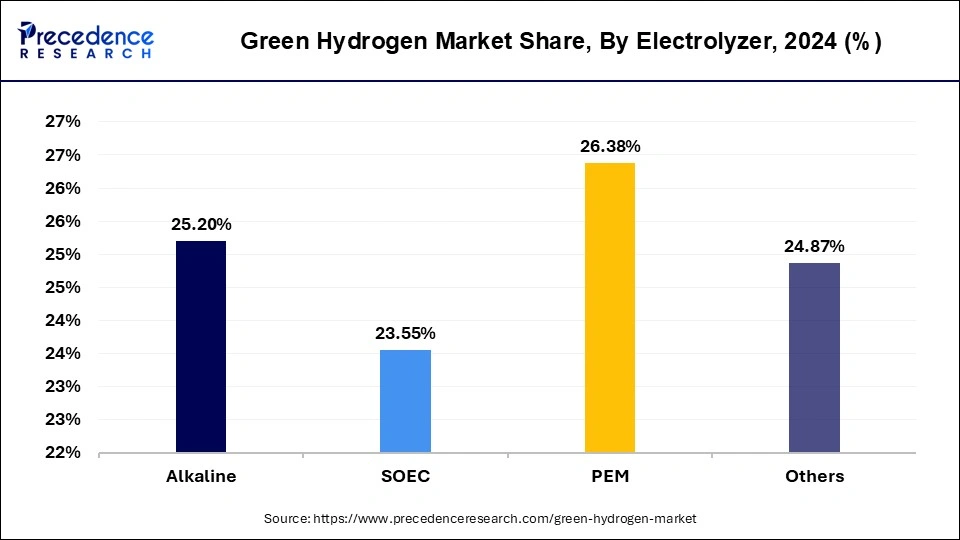
On the other hand, the solid oxide electrolyzer segment is expected to grow at rapid pace during the forecast period. Solid oxide electrolysis uses electrolytes that are easily replicated or interchangeable and have a low corrosive effect on both electrodes. The long life of an electrolyzer is influenced by this factor. Due to the difficulty of hydrogen ions diffusing into an electrolyte solution, alkaline electrolysis tends to create green hydrogen.
Global Green Hydrogen Market, By Electrolyzer Type, 2022-2024 (USD Million)
| By Electrolyzer Type | 2022 | 2023 | 2024 |
| Alkaline | 1,126.9 | 1,578.5 | 2,212.5 |
| SOEC | 1,052.3 | 1,474.5 | 2,067.5 |
| PEM | 1,176.7 | 1,650.5 | 2,316.6 |
| Others | 1,120.8 | 1,564.1 | 2,184.1 |
The wind energy segment held the largest share of the green hydrogen market while contributing 47.68% of the market share in 2024. Wind energy is a widely available renewable resource, with vast potential for harnessing clean electricity generation. Wind turbines can be installed onshore or offshore, utilizing the natural movement of air to generate electricity without emitting greenhouse gases or pollutants. Wind energy has become increasingly cost-competitive with conventional fossil fuel-based electricity generation. The declining costs of wind turbines, installation, and maintenance have made wind power an economically viable option for green hydrogen production, enabling cost-effective hydrogen production through electrolysis using wind-generated electricity.
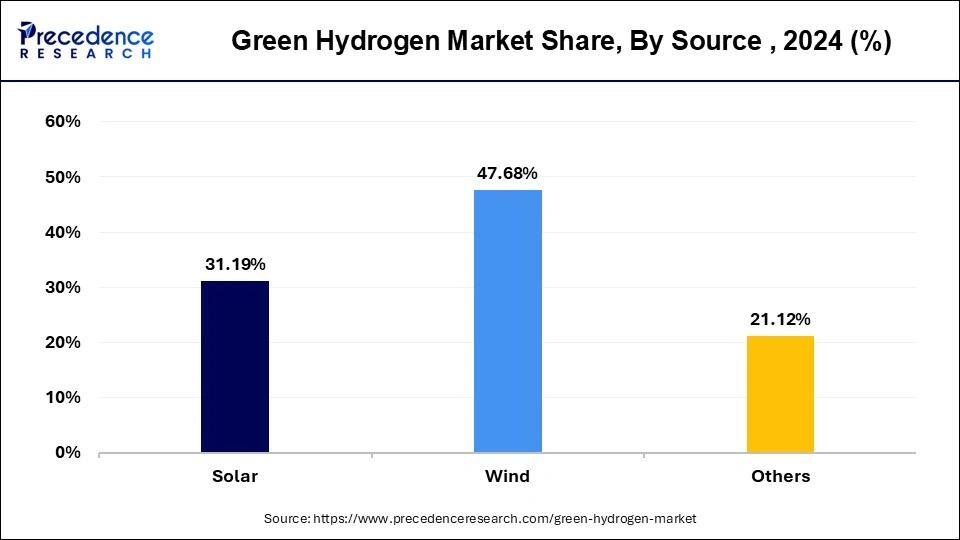
Global Green Hydrogen Market, By Source, 2022-2024 (USD Million)
| By Source | 2022 | 2023 | 2024 |
| Solar | 1,394.6 | 1,953.8 | 2,739.1 |
| Wind |
2,128.7 | 2,984.4 | 4,186.9 |
| Others |
953.4 | 1,329.3 | 1,854.7 |
The refining segment held the dominating share of 41.85% of the green hydrogen market in 2024. Refineries have existing infrastructure and expertise in handling and processing large volumes of gases and liquids. This infrastructure can be repurposed or modified to accommodate hydrogen production, allowing refineries to enter the green hydrogen market relatively quickly and cost-effectively. Many refineries are investing in research and development (R&D) to develop and commercialize innovative green hydrogen production technologies. This includes advancements in electrolysis technology, catalysts, and renewable energy integration, which can further enhance the efficiency and cost-effectiveness of green hydrogen production within the refining sector.
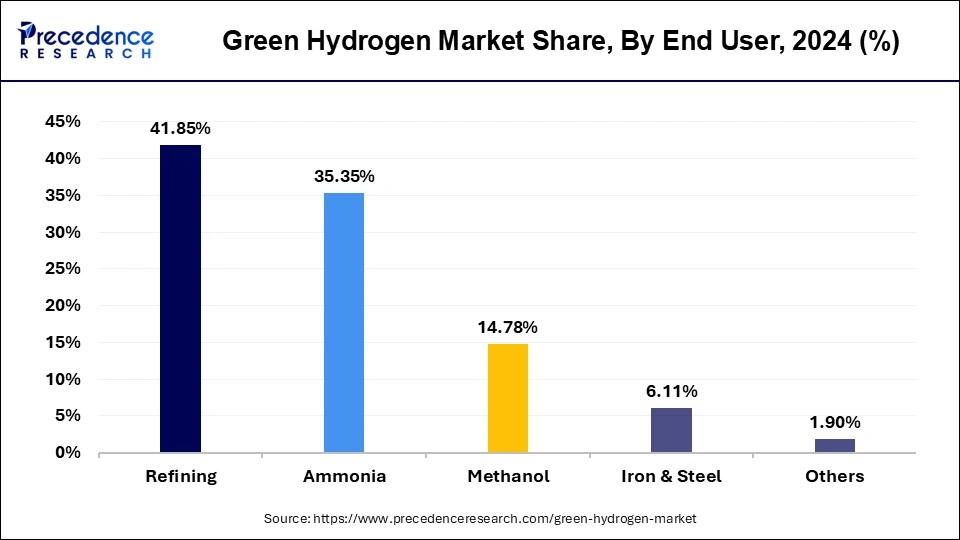
Global Green Hydrogen Market, By End User, 2022-2024 (USD Million)
| By End User | 2022 | 2023 | 2024 |
| Refining | 1,869.9 | 2,620.5 | 3,675.1 |
| Ammonia |
1,579.1 | 2,213.2 | 3,104.2 |
| Methanol |
658.7 | 924.3 | 1,298.0 |
| Iron & Steel |
271.4 | 381.6 | 536.7 |
| Others | 97.7 | 127.9 | 166.8 |
In the green hydrogen market, there is fierce rivalry to reduce manufacturing costs, develop innovative process technology, expand, and enhance the usage of green hydrogen in end use sectors. The key market players are attempting to grow their market shares by employing various techniques in response to such possibilities in the sector.
By Electrolyzer
By Source
By End User
By Geography
For inquiries regarding discounts, bulk purchases, or customization requests, please contact us at sales@precedenceresearch.com
No cookie-cutter, only authentic analysis – take the 1st step to become a Precedence Research client
May 2025
June 2025
April 2025
May 2025